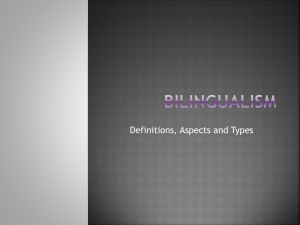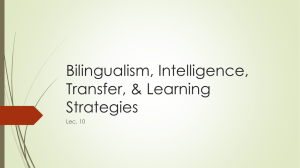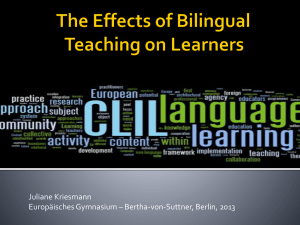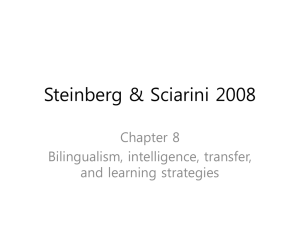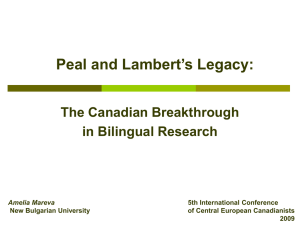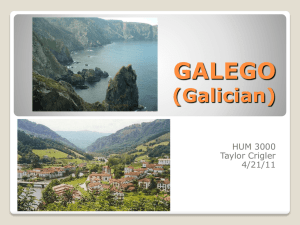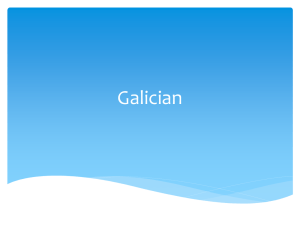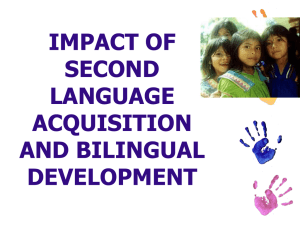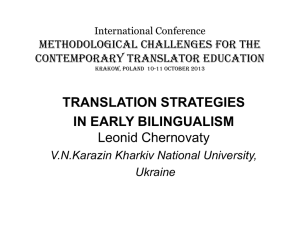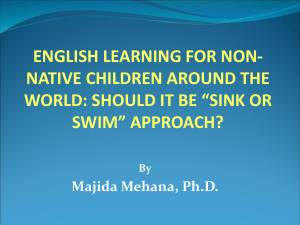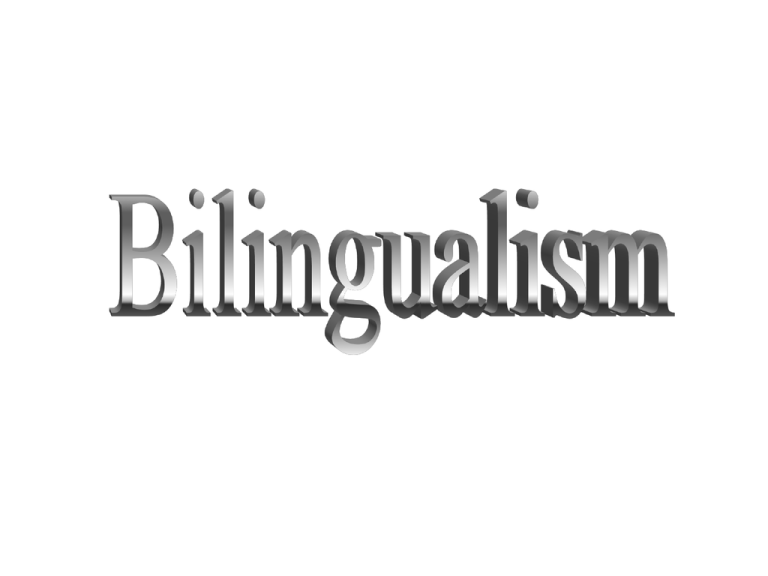
Bi lingual ism
“two”
“articulated with
the tongue”
suffix that
describes an
action or
process
• Bloomfield, 1933: “Bilingualism is the native-like control of two
languages”
• Haugen, 1953: bilingualism begins “at the point where the speaker
of one language can produce complete meaningful utterances in the
other language”
• Diebold’s, 1964: Incipient bilingualism “the initial stages of contact
between two languages”
• Mackey, 1968: “the alternate use of two or more languages”
– Degree – focus on ability. How well does the bilingual know each of the
languages?
– Function – focus on the uses the speaker has for each of the languages
and the roles these languages play.
– Alternation – focus on to what point the individual alternates between
the languages.
– Interference – focus on to what point the speaker is able to distinguish
between the two languages, keeping them apart or allowing them to
merge together.
Types of Bilingualism
•
•
•
•
•
Individual Level
Weinreich (1967)
Coordinate bilingualism
Compound bilingualism
Sub-coordinate bilingualism
Coordinate bilingualism
• The learning of two languages in two different settings
the words of the languages are kept completely
separated
each word has its own independent meaning
• E.g. school bilingualism: an English student studying
Spanish at school = 2 languages, 2 different contexts.
• Book .v. libro
Book
Libro
Compound bilingualism
• The learning of two languages in the same context, used at
the same time
• The two languages have an amalgamated representation;
inter-reliant
• Loewe (1888) “two-member system of the same language”
• E.g. cultural bilingualism: an individual at home who has an
English mother and Spanish father, and speaks the two
languages with their parents.
Book
Libro
Sub-coordinate bilingualism
• Individual interpreting the words of his weaker
language via the words of his/her stronger language
• The bilingual has one set of meanings established
through his/her’s first language, with a different
linguistic system attached to them.
E.g. a Spanish person hears the word “book” in
English, relates the word to their stronger language
(libro) inducing the meaning of the word in English.
Book
Libro
Book
Types of Bilingualism
• Social Level (diglossia)
• Fisherman et al. (1966)
• Typologies of bilingualism based on
societal variables focusing on the prestige
and status of the languages involved.
• Elite
• Folk
Bilingual behaviour
• Code-switching
• Gumperz (1982): “the juxtaposition within the same
speech exchange of passages of speech belonging to
two different grammatical systems or subsystems”
• Borrowing
• Johanson (1992): “the copying of a form from one
language system (the lexicon of Y) into another (X)
• Interference
• Haugen (1956): “the overlapping of two languages, or
application of two systems to the same item”
Language maintenance,
shift and death.
Examples of factors that can affect shift, maintenance and death;
•Numerical strength: Large minority groups often stand a better chance of
maintaining their language, with more people to mobilize it.
•Social class: the people who speak a language also play an important role its
survival rather than the number of people that speak it.
•Ties with the homeland/native language: Refugees may reject their first
language owing to its connections with the turmoil they left behind.
•Exogamous marriage: In Wales, due to an out-migration of Welsh speakers
and an influx of English speakers, the number of exogamous marriages (in
which English almost always dominates) now equals those in which both
partners are Welsh (data collected 1981).
•Attitudes of the majority towards the minority: “If speakers of the minority
language manage to find an ecological niche in the majority community, which
is conducive to language maintenance, they may have a better chance of
survival.” (Romaine, 1989).
•The relationship between dialect and standard: With regards to education,
“when the extent of the difference between the variety spoken at home and the
school standard is substantial, children may experience considerable
difficulties.” (ibid).
Types of bilingual communities
• In an extreme case a community may have strict
separation of domains with stable bilingualism.
• Conversely, a community’s bilingualism may be
very unstable using both languages in all
domains.
• Intermediate communities may use one language
for certain domains but both in others.
Domains and other sources of variance in language
behaviour
• Media variance: Writing, reading and speaking: The shift and
maintenance of a language can be affected by the point at
which each language media is obtained.
• Role variance: The degree of shift and maintenance may
also be affected by inner speech, comprehension and
production.
• Situational variance: Shift and maintenance may also relate
to how formal or intimate the communication is.
• Domain variance: There are several distinguishable domains
of language behaviour which may affect the degree of shift
and maintenance. E.g. autonomy, power, influence, domain
centrality.
Group, situation and topic in language choice
Group:
•
•
Group membership can be observed with criteria such as age, sex, race
and religion.
It is also apparent in a socio-psychological sense of reference group
member.
Situation:
•
•
•
Aspects of ‘situation’: participants, physical setting, topics and functions.
Style; intimacy-distance, formality-informality, solidarity-non-solidarity,
status equality-inequality.
Bilinguals usually view one of their languages to be more dialectal.
Topic:
•
•
Certain topics tend to be handled better in one language than the other.
A language may deal with a certain topic better than another because the
latter lacks the specific terminology required of the subject.
Grosjean’s view on language choice
Four factors that may affect the choice of language;
• the setting and situation,
• the participants in the interaction and their roles in
relation to one another,
• the topic (work, sports, national events),
• the function of the interaction.
Loanwords: Catanyol
Spelling:
-"extendre" instead of "estendre" –also
"extens" and "extensió"– (extend)
-"extranger" and "extrany" instead of
"estranger" and "estrany" (foreigner/ foreign)
Loanwords: Catanyol
Morphology
Changes in verbal conjugation:
•
•
•
•
-"abastir" instead of "abastar".
-"aclarar" instead of "aclarir". (Clarify)
-"reflexar" instead of "reflectir". (Reflect)
-"combatir" instead of "combatre". (Fight)
Loanwords: Catanyol
•
•
•
•
•
•
•
•
•
•
•
Morphology:
Prepositions and conjunctions :
-"a causa de", "per raó de" instead of the Castilian "degut a" (taken
from the English 'due to').
-"a finals de" instead of the original "a la fi de", "a la darreria de", "al
final de".
-"a principis de" instead of the original "al començament de, "al
principi de". (At the beginning of)
-“no obstant” instead of ”no obstant això" o "això no obstant".
-"per a" and not "per", in all the cases.
-"sempre que" and not the Castilian "sempre i quan".
-"tal com" and not "tal i com".
prefixes and suffixes:
The Castilian suffix –ar substitutes the Catalan –ari.
- "interdisciplinar" instead of "interdisciplinari".
Loanwords: Catanyol
•
•
•
•
•
Lexicology: Locutions
-”Anar a més" (cast. "ir a más") (to increase) : Anar més
lluny, progressar
-"Brindar una oportunitat" (instead of the Catalan "donar
una oportunitat") (Bring an oportunity).
-"Fer la pilota" (that in Catalan would be said: "fer la
rosca")(to suck up to someone)
-"Fer-se el suec" (instead of the traditional "fer el
longuis" o "fer l'orni") (to act dumb). In Catalan the
pronoun “se” in these kind of expressions is not used.
(e.g.: *"fer-se el sord" - "fer el sord").
- "Fet i dret" (cast. "hecho y derecho") instead of "de cap
a peus".
Code-switching: Example
• [Cat.]
El tercer dia es el pitjor. El primer està bé, perquè ets
màrtir. El segon, aguantes perque ho vas fer el primer.
Però, el tercer, et dius; [Cast.] “¡¡No puedo más!! ¡¡Me
da igual!!”
• (The third day is the worst. The first is okay, because
you’re a martyr. The second day, you bear it because
you did it the first day. But the third day you say to
yourself, “I can’t stand it any more!! I don’t care!!”).
Language Competence in the BAC
(Language competence in the BAC across age groups (1996
Census data)
USE OF GALICIAN CONDICIONATED BY SOCIAL VARIETIES
Age: Galician: Main language to old people (80’ 6 %)
Main language to young people under 25
(36’7%)
•
Place where you live: Galician: Main language in the villages
(85’8%)
Main language in the cities
(16’7 %)
Studies and jobs:
- Studies:
People with studies: Galicia, as main
language (19’1 %)
Peoble without studies: Galicia as a
main language (92’6%)
- Jobs:
Unskilled worker: Galicia, as main language (96’1 %)
Skilled worker: Galicia, as main language (14’2 %)
PERIODS IN HISTORY AND SPEAKERS IN GALICIA
1. 1919- 1949 ( Ages: 60- 90 years old)
•
Most of the people lived in villages and spoke Galician
•
There was no education in Galician Galician was transmitted
between generations without an education.
•
Not to much education in Castilian.
MONOLINGUALISM IN FAVOUR OF THE GALICIAN
DIGLOSIA:
-Formal situations: Castilian
- Informal situations: Galician
2.
1949- 1969 (Ages: 40- 60 years old)
•
•
•
Galician was forbidden
People were educated in Galician
A separation between “ life in the country” and “life in the city”
conditions the use of the language -> DIGLOSIA
Feeling of shame -> LOSS OF GALICIAN
•
3.
•
•
1969- 1984 (Ages: 25- 40 years old)
People were educated in Castilian
Galicia become a minority language
BILINGUISM: in villages
MONOLINGUALISM: in cities
DIGLOSIA:
-Formal situations: Galician
-Informal situations: Castilian
4. 1984- Today (Ages: under 25 years old)
•
The language most used in cities is Castilian ->
MONOLINGUALISM
•
People were educated in Castilian, but their parents spoke
Galician.
People heard Castilian in routine situations, but they decide start
to study it
•
BILINGUALISM
•
People as victim of the new situation of diglosia
Conclusion
PROCESS OF ‘DESGALEIZACIÓN’
REVERSE PROCESS OF DIGLOSIA
Key scholars
• Charles A. Ferguson (1921-1998)
Diglossia, 1959, Word vol. 15: 325-340
-introduces the concept
• Joshua A. Fishman (1926-)
-develops Ferguson’s ideas
-introduces ‘extended bilingualism’
Ferguson’s definition of diglossia
a relatively stable language situation in which, in addition
to the primary dialects of the language (which may
include a standard or regional standards), there is a very
divergent, highly codified (often grammatically more
complex) superposed variety, the vehicle of a large and
respected body of written literature, either of an earlier
period or in another speech community, which is learned
largely by formal education and is used for most written
and formal spoken purposes but is not used by any
section of the community for ordinary conversation
(1959)
Ferguson’s definition of diglossia
• “a specific relationship between 2 or more varieties of
the same language in use in a speech community in
different functions” (1972: 232)
• One variety is superposed, labelled H, whilst the other
variety(ies) are L and can be distinguished through their
functional specialisation
NB. Polyglossia = when more than two varieties are
involved
Typical situations for
H and L varieties
•
High usages:
sermon in church/mosque
personal letter
speech in parliament/political speech
university lecture
news broadcast
newspaper editorial, news story
poetry
•
Low usages:
instructions to waiters
conversations with family, friends, colleagues
radio soap opera
caption on political cartoon
folk literature
•
Overlap between the two - in all defining speech communities it is typical to
read aloud from a newspaper in H and discuss its contents in L.
Areas in which H and L differ
• Function – H and L different purposes, native speakers would find it odd if anyone
used H in an L domain or L in an H domain
•
•
•
•
•
•
•
•
Prestige – H more highly valued
Literary heritage – literature normally in H variety, no written uses of L
Acquisition – L variety learned first, H acquired through schooling
Standardisation – H strictly standardised, L rarely standardised
Stability – diglossias generally stable
Grammar – H more complex than L
Lexicon – often shared, but differentiations in vocabulary
Phonology – two kinds of systems – H and L share same phonological elements but
H has more complicated morphophenomics, or where H has contrasts that L lacks but may borrow
Diglossic communities
• Haiti
H – French
L - Haitian creole
• Switzerland
H – standard German
L – Swiss German
• Egypt
H – Classical Arabic
L – colloquial Arabic
Institutional support systems
• L typically acquired at home as a mother tongue – continued
use throughout life – familiar interactions
• H learned through socialisation and never at home
• Diglossic societies are marked by access restriction – i.e.
entry to formal institutions such as school and government
requires knowledge of H
• Importance attached by community members to using the
right variety in the appropriate context – speakers regard H as
superior to L in a number of respects
– in some cases speakers claim they do not speak L
– alleged superiority for religious and/or literary reasons
– strong tradition of formal grammatical study and standardisation
associated with H
How does diglossia come about?
Examples:
• -sizeable body of literature in a language
closely related to natural language of the
community - this literature embodies some
of the fundamental values of the group
• -literacy in the community limited to a
small elite
Power and prestige
• H - greater international prestige, language of
the local power elite, or dominant religious
community
• H-variety language = language of more powerful
section of the society
• French Canada – English (H)
– greatest prestige in North America and internationally
– population numerically greater than community of
French speakers,
– speech community is economically dominant, in both
the English and French areas of Canada
Fishman’s diglossia
• Extended diglossia:
includes speech communities in which the high
and low varieties are not necessarily close
related varieties
Two or more varieties are mother tongues, each of
different segments of the population
Paraguay – Spanish (H), Guarani (L)
-both are mother tongues for different groups
Fishman’s extended diglossia
• 4 variations of linguistic relationship between H’s
and L’s
– H as classical, L as vernacular, the two being
genetically related
– H as classical, L as vernacular, the two not being
genetically related
– H as written/formal-spoken and L as vernacular, the
two being genetically unrelated to each other
– H as written/formal-spoken and L as vernacular, the
two being genetically related to each other
Diglossia vs. Bilingualism
• ‘Bilingualism’ - two languages of an
individual
‘Diglossia’ - two languages in society
• Fishman - the relationship between
societal diglossia and individual
bilingualism is not necessary or causal
• bilingualism with and without diglossia
• diglossia with and without bilingualism
Diglossia without Bilingualism
• political or governmental diglossia - two or more
differently monolingual entities brought together
under one political roof
• Canada, Belgium, Switzerland
• institutional protection for more than one
language at the federal level, though widespread
monolingualism in individual territories
• Both diglossia with and without bilingualism tend
to be relatively stable, long-term arrangements.
Examples of diglossia in Spain
• The first and most notable is the case of
Galician. There still exists one
fundamental problem in the region
according to Loureiro-Rodríguez:
The fact that the Galician language has been
historically considered inferior, even among
the majority of its speakers, has made the
functional and realization process more
challenging (2007:123)
• Galician has traditionally been an oral language,
with Castilian being used for written
communication; as such it gains a level of prestige
as it is the language used for official purposes.
• For the majority of older speakers of Galician (the
category which has the highest number of
speakers) they were never educated in Galician,
solely in Castilian, and so there has always been a
diglossic situation, using Galician as there means
of oral communication but switching to Castilian
for written communication.
• Since becoming co-official in the region
Galician went through a process of
normalisation to create a standard version
of the language.
• However the ‘standard’ that was produced
did not reflect the many local varieties of
the language.
• What developed then were high and low
versions of Galician, the ‘standard’ variety
which was considered as high, and the local
variants considered to be the low varieties.
• As a result when in a more official
environment, the speakers of the ‘low’ variety
often opt for speaking Castilian instead of
Galician because they do not feel confident
with the ‘high’ variety.
• A contrary example but one which still focuses on
diglossia is Catalonia.
• Unlike Galicia, Catalonia receives high numbers of
immigrants, particularly from other areas of Spain.
• In Catalonia the majority of public life is carried out
in the medium of Catalan and as a result it has
prestige within the region, and thus when
considered alongside Castilian it is seen as the
high variety with Castilian as the low variety.
• Those people that move to the region that are
not Catalan speaking find themselves in a
diglossic situation:
No doubt many of them feel socially
disadvantaged as they often come from a low
socioeconomic background and live in poor
housing areas, often in large, homogenous
groups. For everyday purposes they probably
don’t need to use Catalan, although of course,
they may resent to feel in a linguistically inferior
position (Hoffman, 1996:75)
• My final example of diglossia in Spain is
that of Aranés in the Valle de Arán.
• Almost all the inhabitants of this region
speak Aranés and use it at home and
family circles. However the language of
administration in the region is Castilian.
• And so we have a classic case of diglossia, with speakers of
Aranés switching to Castilian depending on the circumstance
such as official or administrative purposes.
El uso fuera del entorno familiar está dominado por el
castellano, sobre todo en las generaciones más jóvenes. Por el
contrario, en cuanto al conocimiento de la lengua, ha
aumentado, por efecto de la escolarización en aranés. Lo que
muestra que los medios puestos para la enseñanza de la lengua
en la escuela han sido muy superiores a las medidas de política
lingüística que iban dirigidas a fomentar su uso. Lo que muestra
la necesidad urgente de una activación de las medidas
destinadas a la promoción y uso de la lengua, que fuera llevada
a cabo con la seriedad y el rigor necesarios. (Etxebarria,
2002:311)
Bibliography
•
•
•
•
•
•
•
•
•
•
•
Skutnabb-Kangas, Tove .Bilingualism or not : the education of minorities / Tove Skutnabb-Kangas / t . Clevedon : Multilingual Matters, 1981 .
Grosjean, F (1982). Life with two languages; Massachusetts, Harvard University Press.
Romaine, S (1989). Bilingualism. Oxford, Basil Blackwell.
Benjamins, John (2008). Bilingualism and Identity: Spanish at the crossroads with other languages.
Edited by Niño-Murcia, M. & Rothman, J. Amsterdam: John Benjamins Publishing Co.
Hoffman, Charlotte ‘Monolingualism, Bilingualism, Cultural Pluralism and National Identity: Twenty Years
of Language Planning in Contemporary Spain’, Monolingualism and Bilingualism Lessons from Canada
and Spain, Ed. Sue Wright (Clevedon; Philadelphia; Adelaide: Multilingual Matters Ltd., 1996)
Etxebarria, Maitena La Diversidad de Lenguas en España, (Madrid: Editorial Espasa, 2002)
Loureiro-Rodríguez, Verónica ‘Are Galicians bound to diglossia?’ Spanish in Contact: Policy, Social and
Linguistic Inquiries, Ed. Kim Potowski and Richard Cameron (Amsterdam; Philadelphia: John Benjamins
Publishing Company, 2007)
Conde, Xavier Frías ‘A Brief Outline of Historical Sociolinguistics of the Galician Language’, Romania
Alternativa
Rei-Doval, Gabriel, A Lingua Galega Na Cidade No Século XX: Unha aproximación sociolingüística
(Salamanca: Edicións Xerais de Galicia, 2007)
Maria Yanhez e Monica Ares. Linguas cruzadas (2007)
Manuel González González, Modesto A. Rodriguez Neira, Antonio Fernández Salgado, Xaquín, Loredo
Gutiérrez, Isabel Suárez Fernández, Mapa sociolinguistico de Galicia 2004. Volumen I. Lingua inicial e
competencia linguistica en Galicia.

